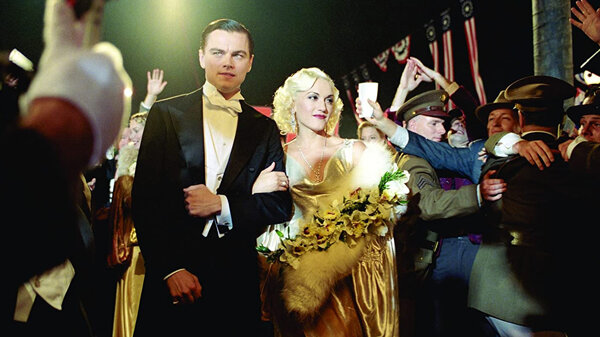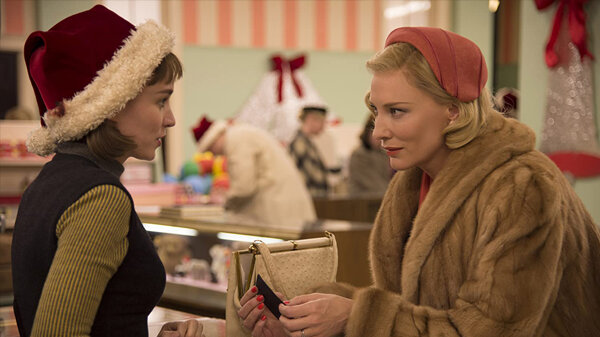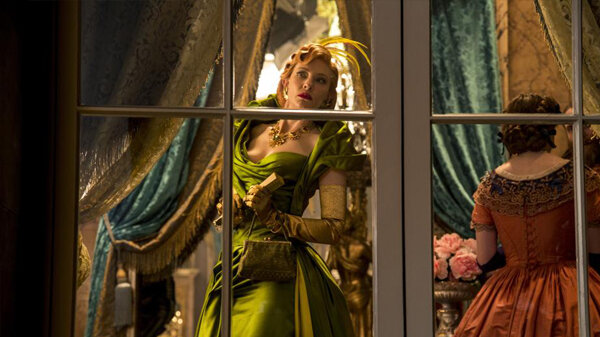Whether it’s in stories of princesses or lovers, femmes fatales of devastating aviators: there’s only one woman to dress them for the job. The inimitable Sandy Powell has produced some of the finest costumes ever made for the silver screen – Emma Fraser looks back on the designer’s singular vision.
A pair of gloves left on a counter, a lost glass slipper, and a gown fit for an extravagant movie premiere. These garments and accessories provide the foundational building blocks of Carol, Cinderella, and The Aviator. Three-time Oscar winner Sandy Powell has a career stacked in spellbinding costume design moments that have turned her into a household name akin to the late great Edith Head, a trailblazer in this profession who inspired The Incredibles cartoon stylist Edna Mode. When Powell walked the red carpet at this year’s Academy Awards, her short David Bowie Hunky Dory era hair was statement-making. Coupled with her unique suit covered in signatures from celebrities — which she auctioned off to help save mentor Derek Jarman’s cottage — Powell’s headline-stealing look was one of the standouts, rivalling A-listers like Brie Larson, Janelle Monáe and Natalie Portman. Using clothes to enhance a story on screen is one thing, but Powell also delivered an award season narrative using her own closet.
Costume design isn’t simply about putting an actor in an outfit to support the time period or differentiate social class, nor is it a vanity project to make the performer look good. Rather, it is a vital aspect of visual storytelling. A dress is never just a dress, no matter how pretty it is. In a career spanning more than 30 years, Powell has racked up 15 Oscar nominations, including three separate years as a double nominee — she beat herself in 1999 and 2019. Longstanding collaborations with Martin Scorsese and Todd Haynes have produced 11 movies in total, beginning with Gangs of New York and Velvet Goldmine (she is currently working on movie number eight with Scorsese). One strand weaving its way throughout Powell’s work is her penchant for period-set narratives, covering multiple centuries and genres. What links the material is her ability to breathe life into not only the clothing of the principal actors, but also the often crowd-heavy background. And no matter how gritty the setting, the garments infuse magic into the texture of the movie.
Another thread capturing the essence of Powell’s work come via repeat collaborations with Cate Blanchett in roles crisscrossing decades and genres, from the couture-clad villainous step-mother in Cinderella to Hollywood icon Katharine Hepburn in The Aviator. ‘Icon’ is an overused descriptor, at risk of losing all meaning, but there is no doubt Hepburn is in the upper echelon in her acting ability, personal style, and the costumes she wore. In The Aviator, Powell was tasked with making garments that exist in photographs and on screen for the depictions of Hollywood starlets like Ava Gardner and Jean Harlow, however, as with historical accuracy, the role of the costume designer is not to recreate or reproduce exact replicas, but to bring these characters to life in a new way.
My initial interest in this aspect of filmmaking is a rather simplistic one, stemming from my love of clothes and a desire to wear pretty and tailored things. The theatrics of runway presentations — whether the lavish couture or slightly less lavish ready-to-wear — elevates garments that will trickle down into fashion magazines before the more affordable high street interpretations (think the cerulean blue speech from Devil Wears Prada). Film and fashion are intrinsically linked with movies such as Metropolis, The Matrix, and Alien all influencing collections by Givenchy, Christian Dior, and Alexander McQueen. There is no denying the catwalk tells a story, but the role of costume within a film is vital to the texture of the narrative and character. The costume designer creates an intrinsic part of the fictional world, but they also have the ability to break through this bubble and inspire the viewer in what they wear. Clothes are functional, but you can also indulge in the fantasy of taking a step back in time or into another world via your own sartorial choices. The designer’s power is in creating magic on screen, which can leave its physical mark in the garments that end up in your closet.
“Not everything has to be extravagant to be impactful,” Powell told W Magazine in a recent profile while discussing the stunning costumes from Nicolas Roeg’s Don’t Look Now — another personal favourite of mine. And for all the sumptuous pieces that spring to mind when considering her work on The Aviator, Carol, and Cinderella, the more subtle items are just as intrinsic to the storytelling and its lasting impact. Carol’s fur coat is part of her glamorous allure, doubling as her armour against the world — an extension of her identity embodying the post-WWII fashion transition also indicating her wealth. In the department store meet-cute with Therese, it is casually slung over her shoulders. Later, it fills the frame when Therese takes her first candid photographs of Carol, signifying her larger-than-life magnetic pull. It is the fairy tale garment that is now taboo (faux fur will more than suffice for any contemporary Carol-inspired outfits, but Powell used recycled fur for this custom-build), however, another far simpler piece holds greater significance.
The plaid robe of intimate motel living is striking because it isn’t what would be considered as erotic bedroom material. Understated arousal is also depicted in how Haynes focuses on wrists, necklines, and ankles as erogenous zones — enhanced by costumes — the subtle sexuality of this cosy garment, rather than obvious silk and lace, only adds to the dream-like scenario. Plaid has a language of its own. It is worn by Therese and the guys she hangs out with throughout the film: it is youthful and signifies a different class. Nevertheless, at this point in the movie, no one else but Therese and Carol exists, and this popular pattern is a visual tether between lovers.
The love connection in Cinderella also hinges on a lost garment, but the glass slipper cannot simply be mailed to its owner. The technical aspects of Cinderella’s ball gown underscore that an out-of-this-world frock is possible without VFX. Made from 217 metres of fabric using four miles of thread for the hem alone, Powell told the Los Angeles Times, “One dress took 20 people 500 man-hours to create.” Eight were made in total, incorporating 10,000 Swarovski crystals into the top layer of the fabric, which when combined with the cornflower blue, lilac, and green layers, delivers a shimmering watercolour effect. This isn’t movie magic creating an illusion, but a fantasy brought to life.
Cinderella’s dress is the obvious focus, but Cate Blanchett’s sequin and floral embellished bodice worn during her introduction as the stepmother is villainous intimidation via an exquisite use of rich materials. Referring to this movie as “Once upon a time period” consisting of 18th and 19th-century references, Powell designed the evil stepmother and her two daughters through the lens of how 1940s movies imagined this period. Channelling Joan Crawford in both the padded shoulder costumes and her performance— even leopard print makes an appearance — Old Hollywood glamour is infused into this depiction, finding new life in a well-known story.
Taking a trip back to the Coconut Grove featuring a roll-call of screen legends, Martin Scorsese’s decade-spanning Howard Hughes biopic The Aviator delivers a peek behind the gilded curtain. Katharine Hepburn’s relationship with the billionaire covers a significant time period, which begins with a beach introduction featuring my platonic ideal of an outfit — stripes and denim — quickly followed by tailored golf attire and red carpet gowns. Hepburn’s signature masculine-meets-feminine style dominates, nevertheless, Powell also pays homage to costume design royalty Adrian via a dress silhouette drawing on the instantly recognizable Philadelphia Story white and gold creation. Not only is Powell utilizing the flashy era, but she is seamlessly weaving other design references into the garments. In The Aviator, Jean Harlow and Ava Gardner also play a role in Hughes’ choice of arm candy starlets, further adding to the “Hollywood as a fantasy playground” aesthetic.
Experiencing a different world for two hours is the gift of cinema, but the true visionaries are the ones who linger long after the credits have rolled. Powell’s strengths lie in her ability to evoke an emotional response to a costume: in Cinderella, the ball gown is technically brilliant but it is the decadent menace of Blanchett’s stepmother which has a lasting impact. Drawing on Hollywood legend Joan Crawford establishes a deeper connection to the viewer, weaving the thread of cinematic history through this modernized fairy tale. The Aviator is more overt in this connection between the glamour of Tinseltown and the expectations placed on depicting a screen legend. The starry-eyed wonder of this Katharine Hepburn portrayal is enhanced by how Powell interprets her singular clothing taste. It is impossible to watch Blanchett’s rotation of sumptuous frocks and tailored blazers and not get caught up in the grand adventure Hughes initially offers her. Meaning is ascribed to clothing for countless reasons, but nothing resonates more than the ache of an all-consuming love. The alluring fur coat introduction, Therese’s Santa hat, and the plaid robe are part of the romantic tapestry in Carol, evoking desire and a lingering attachment that is impossible to shake.
Storytelling is much more than the words on the page or a gesture from an actor. Costume design is part of the language of film of which Sandy Powell is one of its best orators. Without her voice, these films would lack their essence and my closet would lose its inspiration. And every fairy tale deserves its happily ever after.
Emma Fraser (@frazbelina) is a freelance television and film writer with words at Little White Lies, Vulture, SYFY FANGRRLS, Collider and more. She loves costume design, '90s teen TV and is currently attempting to learn German.




